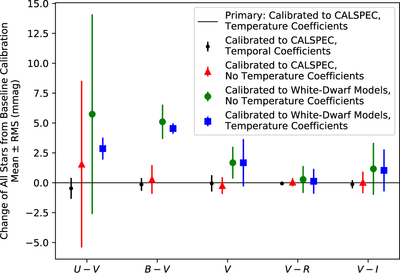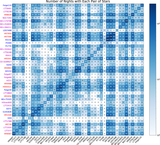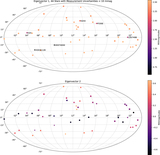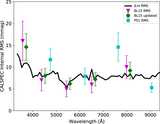Image Details

Caption: Figure 10.
The mean and dispersion (not the uncertainty on the mean) of the per-star changes in synthetic photometry for different analysis variants compared to our primary calibration to 14 CALSPEC stars, with the inclusion of nightly SNIFS temperature coefficients. The small black points indicate the changes if we regress on time of night instead of temperature (i.e., replace ΔT with Δdate in Equation (5)). This has essentially no effect on the recovered standard-star fluxes (changes are ∼1 mmag), indicating that there is no evidence of changes in the SNIFS calibration during each night that are not driven by temperature changes. The red triangles show our original unblinded calibration: calibrated to CALSPEC but with no nightly SNIFS temperature coefficients. The mean star essentially does not change (indicating good mixing of primary and secondary stars through each night), but scatter of several millimagnitudes from star to star is seen in the U band. Next, the green points show the results from calibrating to the three fundamental CALSPEC white-dwarf models directly (with STIS observations not used at all) with no nightly SNIFS temperature coefficients. We see a shift of ∼5 mmags in the U and B bands, with the same several millimagnitude scatter from star to star. Finally, the blue squares show the three-white-dwarf calibration, but with temperature coefficients. The U and B offsets decrease somewhat, and the star-to-star scatter drops to 1–2 mmags. This indicates that some of the original tension we saw between the three-white-dwarf calibration and the CALSPEC calibration is due to when in the night the white dwarfs tended to be observed. Importantly, it also indicates that our network is rigid, and that changing the primary calibration stars moves the entire network together (at least if nightly temporal or temperature coefficients are used). As for the remaining difference between the CALSPEC observations and models for the three WD fundamental calibrators, it is in line with the disagreement shown around the Balmer jump in Figure 9 of Bohlin et al. (2020).
Copyright and Terms & Conditions
© 2022. The Author(s). Published by the American Astronomical Society.












